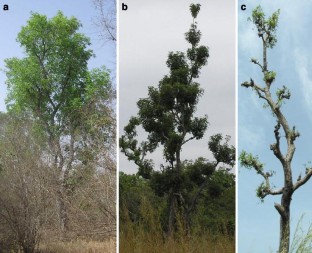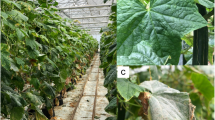Abstract
Fulani Knowledge of the Ecological Impacts ofKhaya senegalensis(Meliaceae) Foliage Harvest in Benin and Its Implications for Sustainable Harvest. An improved understanding of how local people view their impacts on the resources they exploit and how they perceive that their resources are affected by other factors can provide insight into reasons some resources are overexploited and into strategies to conserve them. In West Africa, various tree species are heavily harvested by indigenous herders for foliage to feed their cattle. The reported declines in populations of several of these species have both biological and cultural implications, as cattle are an integral part of indigenous cultures and livelihoods. In this study we investigated Fulani herders’ practices, knowledge, and perceptions of the ecological impacts of harvesting foliage of African mahogany, Khaya senegalensis, in Benin, and we tested some of the factors that may influence them. Fulani herders have detailed ecological knowledge of their impacts on the resources they depend on, and this is finely tuned to local ecological conditions. This knowledge is also widely spread across different sectors of Fulani communities and is highly congruent with scientific findings. However, due to the open-access context of K. senegalensis populations, detailed knowledge of sustainability does not translate into sustainable practices. Fulani perceptions of threats to populations differ significantly between ecological regions and provide key insights for locally relevant resource management plans. Traditional Fulani practices such as the sopoodu provide a basis for sustainable management of proposed Fulani-owned K. senegalensis plantations. This study illustrates how the assessment of local ecological knowledge, practices, and perceptions can play a key role in the design of culturally-appropriate conservation plans.




Similar content being viewed by others
Literature Cited
Alexiades, M. N. 1996. Selected Guidelines for Ethnobotanical Research: A Field Manual. The New York Botanical Garden, Bronx, New York.
Anten, N. P. R., M. Martinez-Ramos, and D. D. Ackerly. 2003. Defoliation and Growth in an Understory Palm: Quantifying the Contribution of Compensatory Responses. Ecology 84:2905–2918.
Arbonnier, M. 2000. Arbres, arbustes et lianes des zones sèches d’Afrique de l’Ouest. 2nd edition. CIRAD, France.
Barrera-Bassols, N. and V. M. Toledo. 2005. Ethnoecology of the Yucatec Maya: Symbolism, Knowledge and Management of Natural Resources. Journal of Latin American Geography 4:10–41.
———, J. A. Zinck, and E. Van Ranst. 2006. Local Soil Classification and Comparison of Indigenous and Technical Soil Maps in a Mesoamerican Community Using Spatial Analysis. Geoderma 135:140–162.
Bawa, K. S., J. W. Kress, M. N. Nadkarni, and S. Lele. 2004. Beyond Paradise: Meeting the Challenges in Tropical Biology in the 21st Century. Biotropica 36:437–446.
Benz, B. F., J. E. Cevallos, F. M. Santana, J. A. Rosales, and S. M. Graf. 2000. Losing Knowledge about Plant Use in the Sierra de Manantlan Biosphere Reserve, Mexico. Economic Botany 54:183–191.
Berkes, F. and C. Folke. 2002. Back to the Future: Ecosystem Dynamics and Local Knowledge. Pages 121–146 in L. H. Gunderson and C. S. Holling, eds., Panarchy: Understanding Transformation in Human and Natural Systems. Island Press, Washington, D.C.
Bernard, H. R. 1995. Research Method in Anthropology: Qualitative and Quantitative Approaches. Alta Mira Press, Walnut Creek, California.
Bierschenk, T. and R. Forster. 2004. L’organisation sociale des Peuls dans l’est de l’Atacora, Republique du Benin: Communes de Kouande, Pehonco et Kerou. Institut fur Ethnologie und Afrikastudien, Johannes Gutenberg Universitat, Mainz.
Bruna, E. M. and N. B. M. Nogueira-Ribeiro. 2005. The Compensatory Responses of an Understory Herb to Experimental Damage Are Habitat Dependent. American Journal of Botany 92:2101–2106.
Burke, B. E. 2001. Hardin Revisited: A Critical Look at Perception and the Logic of the Commons. Human Ecology 29:449–479.
Casagrande, D. G. 2000. Human Taste and Cognition in Tzeltal Maya Medicinal Plant Use. Journal of Ecological Anthropology 4:57–69.
Case, R. J., G. F. Pauli, and D. D. Soejarto. 2005. Factors in Maintaining Indigenous Knowledge among Ethnic Communities of Manus Island. Economic Botany 59:356–365.
Chazdon, R. L. 1991. Effects of Leaf and Ramet Removal on Growth and Reproduction of Geonoma congesta, a Clonal Understorey Palm. Journal of Ecology 79:1137–1146.
Crawley, M. J. 2007. The R Book. John Wiley and Sons, West Sussex, England.
Dalziel, J. M. 1937. The Useful Plants of West Tropical Africa. Academic Press, Crown Agents for the Colonies, London.
Donovan, D. and R. Puri. 2004. Learning from Traditional Knowledge of Non-timber Forest Products: Penan Benalui and the Autecology of Aquilaria in Indonesian Borneo. Ecology and Society 9:3. http://www.ecologyandsociety.org/vol9/iss3/art3/.
Etkin, N. L. 1988. Ethnopharmacology: Biobehavioral Approaches in the Anthropological Study of Indigenous Medicines. Annual Review of Anthropology 17:23–42.
———. 2002. Local Knowledge of Biotic Diversity and Its Conservation in Rural Hausaland, Northern Nigeria. Economic Botany 56:73–88.
Fornara, D. A. and J. T. du Toit. 2007. Browsing Laws? Response of Acacia nigrescens to Ungulate Browsing in an African Savanna. Ecology 88:200–209.
Fraser, D. J., T. Coon, M. R. Prince, R. Dion, and L. Bernatchez. 2006. Integrating Traditional and Evolutionary Knowledge in Biodiversity Conservation: A Population Level Case Study. Ecology and Society 11(2):4. http://www.ecologyandsociety.org/vol11/iss12/art14/.
Gaoue, O. G. 2008. Assessing the Impact of Bark and Foliage Harvest on Khaya senegalensis (Meliaceae) in Benin, West Africa. Ph.D. thesis, University of Hawaii at Manoa, Honolulu.
——— and T. Ticktin. 2007. Patterns of Harvesting Foliage and Bark from the Multipurpose Tree Khaya senegalensis in Benin: Variation across Ecological Regions and Its Impacts on Population Structure. Biological Conservation 137:424–436.
——— and ———. 2008. Impacts of Bark and Foliage Harvest on Khaya senegalensis (Meliaceae) Reproductive Performance in Benin. Journal of Applied Ecology 45:34–40.
Gautier, D., A. Bonnerat, and A. Njoya. 2005. The Relationship between Herders and Trees in Space and Time in Northern Cameroon. The Geographical Journal 171:324–339.
Gemedo-Dalle, T., B. L. Maass, and J. Isselstein. 2005. Plant Biodiversity and Ethnobotany of Borana Pastoralists in Southern Oromia, Ethiopia. Economic Botany 59:43–65.
Ghimire, S., D. McKey, and Y. Aumeeruddy-Thomas. 2004. Heterogeneity in Ethnoecological Knowledge and Management of Medicinal Plants in the Himalayas of Nepal: Implications for Conservation. Ecology and Society 9:6. http://www.ecologyandsociety.org/vol9/iss3/art6/.
Hardin, G. 1968. The Tragedy of the Commons. Science 162:1243–1248.
Huntington, H. P. 2000. Using Traditional Ecological Knowledge in Science: Methods and Applications. Ecological Applications 10:1270–1274.
Keay, R. W. J. 1989. Tree of Nigeria. Clarendon Press, Oxford, U.K.
Kitajima, K., S. S. Mulkey, M. Samaniego, and S. J. Wright. 2002. Decline of Photosynthetic Capacity with Leaf Age and Position in Two Tropical Pioneer Tree Species. American Journal of Botany 89:1925–1932.
Kristensen, M. and H. Balslev. 2003. Perceptions, Use and Availability of Woody Plants among the Gourounsi in Burkina Faso. Biodiversity and Conservation 12:1715–1739.
——— and A. M. Lykke. 2003. Informant-Based Valuation of Use and Conservation Preferences of Savanna Trees in Burkina Faso. Economic Botany 57:203–217.
López-Hoffman, L., I. E. Monroe, E. Narváez, M. Martínez-Ramos, and D. D. Ackerly. 2006. Sustainability of Mangrove Harvesting: How Do Harvesters’ Perceptions Differ from Ecological Analysis? Ecology and Society 11:14. http://www.ecologyandsociety.org/vol11/iss12/art14/.
Luoga, E. J., E. T. F. Witkowski, and K. Balkwill. 2000. Differential Utilization and Ethnobotany of Trees in Kitulanghalo Forest Reserve and Surrounding Communal Lands, Eastern Tanzania. Economic Botany 54:328–343.
Lykke, A. M. 2000. Local Perceptions of Vegetation Change and Priorities for Conservation of Woody-Savanna Vegetation in Senegal. Journal of Environmental Management 59:107–120.
———, M. K. Kristensen, and S. Ganaba. 2004. Valuation of Local Use and Dynamics of 56 Woody Species in the Sahel. Biodiversity and Conservation 13:1961–1990.
McMillen, H. L. 2008. Conserving the Roots of Trade: Local Ecological Knowledge of Ethnomedicines from Tanga, Tanzania Markets. Ph.D. thesis, University of Hawaii at Manoa, Honolulu.
Milner-Gulland, E. J. 2008. New Perspectives on Harvesting as One Driver of Ecosystem Dynamics. Journal of Applied Ecology 45:1–3.
Müller-Schwarze, N. K. 2006. Antes and Hoy Día: Plant Knowledge and Categorization as Adaptations to Life in Panama in the Twenty-first Century. Economic Botany 60:321–334.
Nabhan, G. P. 2000. Interspecific Relationships Affecting Endangered Species Recognized by O’Odham and Comcaac Cultures. Ecological Applications 10:1288–1295.
Nicholson, S. E. 2001. Climatic and Environmental Change in Africa during the Last Two Centuries. Climate Research 17:123–144.
Ofori, D. A., E. Opuni-Frimpong, and J. R. Cobbinah. 2007. Provenance Variation in Khaya Species for Growth and Resistance to Shoot Borer Hypsipyla robusta. Forest Ecology and Management 242:438–443.
Omokanye, A. T., R. O. Balogun, O. S. Onifade, R. A. Afolayan, and M. E. Olayemi. 2001. Assessment of Preference and Intake of Browse Species by Yankasa Sheep at Shika, Nigeria. Small Ruminant Research 42:201–208.
Paeth, H. and A. Hense. 2004. SST versus Climate Change Signals in West African Rainfall: 20th-Century Variations and Future Projections. Climatic Change 65:179–208.
Petit, S. 2003. Parklands with Fodder Trees: A Fulße Response to Environmental and Social Changes. Applied Geography 23:205–225.
R Development Core Team. 2008. R: A Language and Environment for Statistical Computing. R Foundation for Statistical Computing, Vienna, Austria. ISBN 3-900051-07-0. http://www.R-project.org.
Salzmann, U. and P. Hoelzmann. 2005. The Dahomey Gap: An Abrupt Climatically Induced Rain Forest Fragmentation in West Africa during the Late Holocene. The Holocene 15:190–199.
Scoones, I. 1995. Living with Uncertainty: New Directions in Pastoral Development in Africa. SRP, Exeter, London.
Shanley, P. and N. A. Rosa. 2004. Eroding Knowledge: An Ethnobotanical Inventory in Eastern Amazonian’s Logging Frontier. Economic Botany 58:135–160.
Smith, A. H. and F. Berkes. 1991. Solution to the Tragedy of the Commons: Sea-urchin Management in St Lucia, West Indies. Environmental Conservation 18:131–136.
Ticktin, T. and T. Johns. 2002. Chinanteco Management of Aechmea magdalenae: Implications for the Use of TEK and TRM in Management Plans. Economic Botany 56:177–191.
West, C. T., C. Roncoli, and F. Ouattara. 2008. Local Perceptions and Regional Climate Trends on the Central Plateau of Burkina Faso. Land Degradation and Development 19:289–304.
Acknowledgments
This work was supported by grants from the Beatrice Krauss Fellowship and the Ecology, Evolution and Conservation Biology Program at the University of Hawaii at Manoa. We are grateful to the Fulani communities who participated in this research, to Yacoubou Boni, Samba Tobou Adam, and Rachidi Saliou for field assistance, and Ismail Moumouni, Florent Okry, Shimona Quazi, Nina Etkin, Kim Bridges, Andy Taylor, and Don Drake for useful discussion.
Author information
Authors and Affiliations
Corresponding author
Rights and permissions
About this article
Cite this article
Gaoue, O.G., Ticktin, T. Fulani Knowledge of the Ecological Impacts of Khaya senegalensis (Meliaceae) Foliage Harvest in Benin and its Implications for Sustainable Harvest. Econ Bot 63, 256–270 (2009). https://doi.org/10.1007/s12231-009-9091-6
Received:
Accepted:
Published:
Issue Date:
DOI: https://doi.org/10.1007/s12231-009-9091-6




